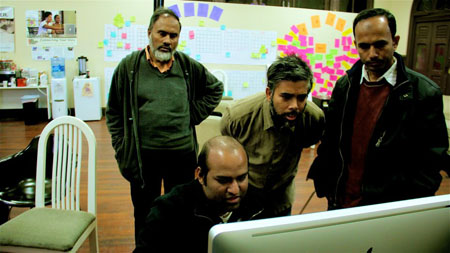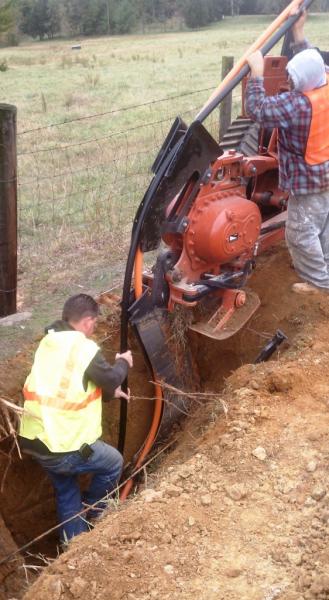Blog
BTOP Case Study Five: Bill Callahan, Connect Your Community Project Director, OneCommunity
As part of our BTOP series: Tales from the Front Lines, today we are highlighting Ohio sustainable broadband adoption grantee One Community.
OneCommunity, a non-profit broadband provider in Northeast Ohio, is using Recovery Act funding to expand innovative broadband adoption work it is doing in Cleveland and replicate the program in seven other communities in Ohio and four other states. The Connect Your Community (CYC) project provides computer classes and broadband training, as well as low-cost equipment and help finding affordable Internet access, to get low-income households online. One key to the program is the CYC Corps, a team of staffers hired in each community to teach computer and Internet basics to others, who are using those skills to look for jobs or even start their own businesses online. Working with eight local partners, OneCommunity says it is on track to produce 26,000 new broadband adopters. (OneCommunity is also using another Recovery Act award to upgrade and expand its fiber-optic network, which connects anchor institutions in Northeast Ohio).

Computer training at a public housing site in Lorain, Ohio.
BTOP Case Study Four: Andrew Buss, Director of Public Programs, Office of Innovation & Technology, City of Philadelphia
As part of our BTOP series: Tales from the Front Lines, today we are highlighting public computer centers in Philadelphia.
The City of Philadelphia is using a Recovery Act award to open or expand 77 computer centers in health and social service agencies, homeless shelters, affordable housing locations and recreation centers in low-income communities across the city. The project, led by Philadelphia's Office of Innovation & Technology, gives the city's most vulnerable residents access to everything from job postings to health information to educational resources on the Internet. It is part of a broader program called KEYSPOT, Powered by Freedom Rings Partnership. The partnership is a coalition of more than a dozen city agencies, grass-roots organizations and universities working to increase broadband adoption rates in Philadelphia. Another lead agency in the partnership, the Urban Affairs Coalition, is using a separate Recovery Act grant to teach digital literacy skills and provide workforce training in KEYSPOT computer centers. Working together, the two projects are providing online access, instruction and support to help all Philadelphia residents participate in today's wired society.

A public computer center in West Philadelphia
BTOP Case Study Three: Mark Shlanta, CEO, SDN Communications
As part of our BTOP series: Tales from the Front Lines, today we are highlighting South Dakota infrastructure grantee SDN Communications.
SDN Communications, a partnership of 27 independent telecom providers covering 80 percent of South Dakota, is using a Recovery Act grant to expand its 1,850-mile, 300-gigabit-per-second fiber-optic network by another 360 miles and add an additional 100 gigabits of bandwidth along high-capacity routes. The project will enable SDN to deliver broadband speeds of at least 10 megabits per second to 300 anchor institutions that will be added to the network, including schools, libraries, hospitals, clinics, public safety agencies, government buildings and National Guard facilities. It will also deliver faster connections to more than 220 anchor institutions already on the system.

SDN construction crew at work
Shlanta said that in a rural state like South Dakota, broadband brings critical new opportunities in healthcare and education. Broadband allows patients who live in rural communities located far from big hospitals to consult with doctors and other healthcare specialists across the state. Broadband also allows school districts to share staff and resources by making it possible for students to remotely attend classes hosted by other districts. One institution that will get faster connections is the Telecommunications Lab at the Mitchell Technical Institute in Mitchell, S.D., which prepares students for careers in the telecom industry and is training workers to operate broadband networks such as those being built with BTOP funds.
BTOP Case Study Two: Susan Walters, Senior Vice President, California Emerging Technology Fund
As part of our BTOP series: Tales from the Front Lines, today we are highlighting California sustainable broadband adoption grantee CETF.
The California Emerging Technology Fund (CETF), a non-profit working to close the state's digital divide, is using a Recovery Act investment to provide computer, digital literacy and workforce training for low-income communities and other vulnerable populations. CETF works through 19 partners statewide, including non-profits that offer job training and career development services for the unemployed and homeless. Two of those organizations, Chrysalis in Southern California and The Stride Center in Northern California, are using Recovery Act funding to train clients in information technology skills and place graduates in IT positions. CETF also works with partners such as the Chicana Latina Foundation and Youth Radio, to raise awareness of the importance of broadband and ensure its programs serve California's diverse population - from Hispanic farm workers in the Central Valley to seniors in San Francisco's Chinatown. Classes are offered in Spanish, Chinese and other languages.

Chrysalis Computer Lab
Tales from the front lines of the Broadband Technology Opportunities Program
The Broadband Technology Opportunities Program is producing jobs, driving growth, providing tools for economic empowerment and improving lives across the country. That was the takeaway from a recent panel discussion at the annual State of the Net conference held in Washington, D.C. last month. The conference, which is organized by the Advisory Committee to the Congressional Internet Caucus, explores the biggest technology policy issues of the day. This year’s conference included a panel devoted to BTOP, a Recovery Act program administered by NTIA that is investing in roughly 230 projects to increase broadband access and adoption around the country.
The BTOP infrastructure projects are bringing broadband to places where it’s lagging and supplying high-capacity connections to schools, hospitals and other anchor institutions that need more bandwidth. These projects are also spurring private-sector investment since local Internet providers can connect to these critical new "middle mile" facilities to serve more homes and businesses. The BTOP adoption programs are teaching computer and digital literacy skills, providing online job search and resume writing assistance, and even training people for technical jobs in the information-age economy. And the BTOP computer centers - located in schools, libraries and other public buildings - are providing broadband access for people who want to go online but lack the resources at home.
BTOP Case Study One: Joe Freddoso, President and Chief Executive, MCNC
As part of our BTOP series: Tales from the Front Lines, today we are highlighting North Carolina infrastructure grantee MCNC.
MCNC, a nonprofit broadband provider that operates the North Carolina Research and Education Network (NCREN), is using Recovery Act funds to deploy or upgrade 2,600 miles of fiber in rural areas across the state. The network will initially deliver speeds of 10 gigabits per second and eventually scale to a 100-gigabit-per-second middle-mile network. It will extend the reach of the existing NCREN system to connect nearly 2,700 additional anchor institutions, including libraries, hospitals and public safety facilities. The new network will also deliver faster and more reliable connections to K-12 schools, colleges and universities already on NCREN. And it will be an important source of dark fiber for commercial Internet providers that want to expand their own systems. MCNC's project is already creating construction jobs and jobs for local vendors such as CommScope in Hickory, N.C., which is supplying fiber and other materials. It is also laying the groundwork for economic revitalization in places such as Kannapolis, N.C., a former textile mill town that is reinventing itself as a biotechnology and life sciences hub.

MCNC construction crew at work.
Advanced Digital Literacy – Opportunities for All Skill Levels
When discussing digital literacy, most conversations center around people's initial contact with computers and learning how the Internet is relevant to their lives; the basics on how to obtain information, goods, and services online; and developing the threshold skills necessary to succeed in the digital economy. These basic skills are building blocks for success, and are the focus of many of our Broadband Technology Opportunity Program (BTOP) projects.
Digital literacy is an ongoing process, however, and “advanced” digital literacy can have tremendous economic impacts – both from the perspective of the person learning marketable computer skills necessary to compete in today’s digital economy, and from the macroeconomic perspective in helping to realize the President’s vision of a more competitive America built to last.
Codecademy, whose work on digitalliteracy.gov is profiled here, is taking advanced digital literacy to the next level by offering free interactive programming lessons for those interested in learning the basics of computer programming online. Codecademy’s Code Year initiative offers free weekly coding lessons only for a time investment of approximately five hours per week. Students will learn extremely marketable skills such as how to build apps and websites. These skills foster entrepreneurship and enhance employability. Codecademy is also participating in the Administration’s Summer Jobs+ program, where it will offer a course called Code Summer+, which is an abbreviated version of Code Year tailored to teaching low-income youth how to build innovative apps online and helping to connect students with tech companies.
The Critical Role Broadband Plays in Today's Economy
This week I had the opportunity to participate in a panel discussion hosted by the National Organization of Black Elected Legislative Women, or NOBEL, that examined how broadband is helping to address many of America’s most pressing challenges.
A robust broadband infrastructure is critical for America to remain competitive in the 21st century. Broadband provides a foundation for innovation, job creation and economic growth. Broadband is also transforming healthcare by enabling patients in rural areas to consult with medical specialists hundreds of miles away. It is opening doors in education by allowing students to take online classes at universities across the country. And it is changing the way we communicate, form personal connections, access information, shop and conduct many everyday transactions.
The Obama administration is working to ensure that more Americans have the resources and skills to share in these benefits and opportunities. This is particularly critical in today’s job market, since many job openings are posted only online and since digital literacy skills are a requirement in many workplaces.
Commerce COMPETES Report: BTOP is Building Infrastructure for the 21st Century
The U.S Department of Commerce today released a comprehensive report on “The Competitiveness and Innovative Capacity of the United States.”
Part of the report explores the federal role in providing a 21st century infrastructure and highlights Administration efforts already underway, including NTIA’s BTOP program, which is expanding broadband access and adoption in communities across the country.
These projects are already having a positive impact on the lives of Americans: new public computer centers are open, free computer classes and job-trainings are underway, and infrastructure projects are under construction. Already, grantees in NTIA’s BTOP program say that they have deployed or upgraded more than 29,000 miles of broadband infrastructure and installed more than 24,000 workstations in public computer centers. In the last quarter, grantees provided more than 755,000 hours of training to around 220,000 participants. And grantees say that their programs have already led to a total of more than 230,000 new broadband subscribers.
Deputy Assistant Secretary Anna Gomez discusses the important role of broadband Internet in boosting America’s competitiveness. (Video Transcript)
Closing the Digital Divide: Focus on Native American Communities
Too many Native American communities are on the wrong side of the digital divide, lacking access to broadband Internet service and to the economic, educational, and health care opportunities that it enables. NTIA’s broadband grants program, funded by the Recovery Act, is tackling this challenge by bringing broadband Internet facilities to tribal lands and providing computer training to tribal communities. We awarded grants to five tribal authorities for infrastructure and public computer center projects, a subset of the more than 60 broadband projects that will directly benefit tribal communities throughout the United States. Here are some examples:
· In the Navajo Nation, an area with rugged terrain and significant poverty, approximately 60 percent of residents lack even basic telephone service. The Navajo Tribal Utility Authority is now constructing broadband infrastructure that will ultimately cover 15,000 square miles in Arizona, Utah, and New Mexico. Among other benefits, the project plans to connect 49 Chapter Houses, which serve as community centers for the Navajo population, and pave the way to bring telemedicine services, such as remote diagnostics and patient consultations, to this rural population.

Navajo Tribal Utility Authority construction crews prepare electric infrastructure for installation of fiber-optic cable in the 550-mile broadband infrastructure project.












